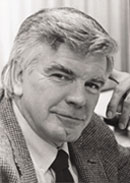

 |
|||
| Alumni
Notes
Losses Geoffrey
Thomas Blodgett
If that amusing proposition reflects some of his skepticism about conventional pieties, it also reveals a durable interest. When he got around to applying for admission, he wrote about growing up on the outskirts of Schenectady, "first as the leader of a well-organized 'army,'and later as a nature-lover, especially in the field of ornithology." The boyish army leader recalled the Second World War, during which he became a teenager. His leadership and sharp-eyed love for nature were evident throughout his life. He
enrolled at Oberlin in the fall of 1949 and received his BA in 1953.
Along the way, he set records as a member of the varsity football
team, was awarded the Carrie C. Life Prize in American History,
was elected to Phi Beta Kappa, and met and wooed his future bride.
He served proudly for two years in the United States Navy and then
launched into graduate study at Harvard. His work there was supported
in part by an Emerton Fellowship in 1955-56 and a Social Science
Research Council Fellowship in 1959-60. Fletcher was best known for his history of Oberlin from its founding through the Civil War. It was a seminal and justly famous work, which showed the value of rigorous, well-informed institutional history. That achievement imposed expectations on Blodgett, and he met them with distinction. He became Oberlin's unofficial historian. His early and brilliant essay on "John Mercer Langston and the Case of Edmonia Lewis," printed in the Journal of Negro History, picked up where Fletcher had left off. Its subject was a bizarre succession of events that occurred in 1862, and in Blodgett's skillful hands it makes a riveting short story. It is a short story with some bite, indeed, for it not only probes the troubled interaction of race and gender–two of Oberlin's durable passions–but it also exposes a convoluted mixture of nobility and hypocrisy that has long characterized its legacy of perfectionism. His knowledge and understanding of Oberlin's history grew steadily and were universally acknowledged. In response to frequent questions and demands, he wrote and spoke on a myriad of topics that have a part in that rich history, from militarism and pacifism to faculty governance to the tensions between what he called "academic excellence" and "stubborn moral idealism." Had he lived to enjoy the long retirement that he had earned, he probably would have published the magisterial history of Oberlin of which he alone was capable. Instead, when he learned that his illness was terminal, he spent much of his diminishing strength on preparing for publication many of his brief essays about the College's past. Thanks to President Dye's support, that work has been assured of publication and will add posthumous luster to his reputation. As a historian, however, Blodgett saw Oberlin as a small piece of a much greater puzzle. Thus, though he gracefully dedicated his first book to Professor Fletcher, its subject was a complex era in American political history. Entitled The Gentle Reformers, and published by the Harvard University Press in 1966, its compelling narrative charts the dedication, the hard work, and the failure of several late 19th-century reformers in Massachusetts for whom the epithet "mugwump" was coined. The mixture of lofty idealism and political ineptitude in those earnest reformers fascinated Blodgett, and it recurs with elegant variations in many of his writings. He once wrote that "the Mugwump gentry," as he called them, "were part of a broad elitist urge to impose the values of coherence, stability, and continuity on a ramshackle society through the assertion of trained intelligence." He excelled at untangling the complexities involved in such collisions and at portraying the human figures who engaged in them. Grover Cleveland, Victoria Woodhull, Frederick Law Olmsted, Ida Tarbell, Henry George, Cass Gilbert: all of them were case studies in that elemental and distinctively American struggle, and all were beneficiaries of Blodgett's scrutiny. His scholarship was remarkable in its range and thoroughness. The high esteem in which he was held within his profession may be gauged roughly by about 50 major book reviews that he contributed to leading journals in history. He admired scholarly distinction in others, just as he demanded it of himself, and he ardently believed that it was the bedrock of excellent teaching. He acted consistently on that belief–for example, as a member of the College Faculty Council (to which he was frequently elected) he was influential in introducing the use of external scholarly reviewers as a hedge against provincial myopia in faculty personnel decisions. He was himself a superlative teacher. His classroom lectures were luminous essays in the craft of history. Former students have testified publically and privately to his powerful impact on their thinking, and many of those students have gone on to distinguished careers as professional historians. The subjects with which he dealt were seminal, embracing the social, political, and intellectual history of modern America. Perhaps the most remarkable course in his portfolio was his widely acclaimed Social History of American Architecture. It had its roots in a course that he took as an undergraduate from Clarence Ward, but he shaped it into a rich summation of his own historical perspicuity. Indeed, he found in architecture a subject that suited his intellectual interests, his grasp of history, his artistic temperament, and his gift for telling stories. His capacious vision meshed with local history when in 1985 he published Oberlin Architecture: College and Town. It is an impressive monument not only to his brilliant sense of local and institutional history, but also to his understanding of history as an artful science and to the artfulness with which he toiled at his craft. At first glance it has the leisurely flavor of a stroll around campus and the village that embraces it, but the description of each building is set within a deep appreciation for the social, political, and intellectual forces that have been at work in the world beyond Plum Creek. Moreover, that combination is backlit by the clarity, vigor, and ingenuity of the Blodgett prose. The book garnered an award from the Western Reserve Chapter of the Society of Architectural Historians, and its popularity led to a second printing in 1990. One notable American architect in particular drew and held his gaze, and that was Cass Gilbert. Gilbert's impact on Oberlin is readily apparent. His importance for American architectural history is just as certain, but less well understood. Blodgett toiled strenuously at the task of shedding light on that tract of darkness, even through the trammels of his final illness. A few days before his death, he was able to hold the first printed copy of his last book, Cass Gilbert: the Early Years. On the day after his death, the Minnesota Historical Society awarded him its prize for the best article published in the year 2000 in Minnesota history. That article, on Gilbert's courtship and marriage, had been a harbinger of the book. Two of his essays on Gilbert–one of them on the Oberlin connection–have been published since his death. The zest, the intellect, the talent that marked his work as a historian informed the rest of his life as well. He was, for example, a splendid photographer. He bought his first camera when he was in Japan during his Navy service, and he hung a memorable display of his photographs in the lobby of Mudd Library during the April weekend in 2000 when his colleagues hosted a dinner in honor of his retirement. He was an indefatigable traveller, and was rarely so happy as when, at the wheel of his beloved Honda Prelude, he tooled along New York highways, listening to country music, bent on a visit to the Springdale Farm of his youthful memories. He was unabashedly patriotic. He conducted an extensive correspondence, and his letters were delicious. He was a vigorous member of the College's Architectural Review Committee, and he had a major hand in the process that led to the building of the Clark Bandstand on Tappan Square. He authored the inscriptions on the campus monument to John Frederick Oberlin and on the Wellington Rescue memorial at Martin Luther King Jr., Park in downtown Oberlin. A visitor to his office on the third floor of Rice Hall would have entered through a door engagingly decorated with an array of cartoons freshly carved from The New Yorker and photocopied excerpts of amusing and pithy texts unearthed during his tireless research. His bookshelves were filled and overflowing onto the floor. A handsome Morris chair, a bust of John Brown, and posters on the wall reflected his taste and enthusiasm as a collector. The gallery of photographic portraits above his desk bore witness to the force of dramatis personae in his own historical imagination. On the shelf beneath the window reposed the typewriter with which he held the computer revolution so long at bay. And in his office chair was Jeff himself, his eyes sparkling and focused on the visitor and ready to celebrate the joy of minds at play, however light or serious the agenda might be. He was born in Hanover, New Hampshire, on October 13, 1931, and died in the library of his Oak Street home on November 15, 2001. He leaves behind his wife, Jane Taggart Blodgett '54; three daughters–Lauren Sharpe, Barbara Blodgett, and Sally Olson; and four granddaughters. His ashes are buried in Westwood Cemetery. Oberlin left its mark on him, and he generously returned the favor: his mark on Oberlin is imperishable. Robert Longsworth is professor emeritus of English at Oberlin. This Memorial Minute was adopted by a rising vote of the General Faculty of Oberlin College on April 16, 2002.
|
|
back to top |
 Geoffrey
Blodgett joined the Oberlin faculty in 1960. When he retired four
decades later, he had served the College longer than any other member
of its Department of History. But his long and remarkable association
with Oberlin did not begin with his appointment to the faculty.
He had first visited the campus at least a dozen years earlier as
a schoolboy, pondering his educational future. In later years he
claimed that what had drawn him decisively to the College was the
sight of a red-headed woodpecker on South Professor Street during
that visit.
Geoffrey
Blodgett joined the Oberlin faculty in 1960. When he retired four
decades later, he had served the College longer than any other member
of its Department of History. But his long and remarkable association
with Oberlin did not begin with his appointment to the faculty.
He had first visited the campus at least a dozen years earlier as
a schoolboy, pondering his educational future. In later years he
claimed that what had drawn him decisively to the College was the
sight of a red-headed woodpecker on South Professor Street during
that visit.